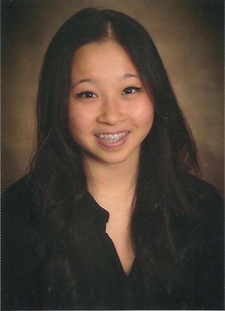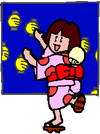Every time the Center [East San Gabriel Valley Japanese Community Center] had a big celebration, but especially at the Installation ceremonies, she would tell me, her lovely eyes wide open:
—Aren’t these children marvelous? Don’t you wish every American kid were like them? Look at how they take care of the “seniors,” especially. I wish I could do something for them…
She went without fulfilling this special wish of her heart, but I just couldn’t forget it; and that’s how the Reiko Moreno Scholarship came to life… The small award, one per year, would be integrated within the larger JACL Scholarship Program’s requirements, but there would be just an additional demand: to write a small essay, some 500 words about how the Center has impacted the life of the applicant.
Of course, all rules have at least one exception; and since this year two applicants submitted such beautiful copy, we decided to make two awards.
Meet the winners:1
Ellyn Noriko Kwan, 19
Ellyn recently graduated from Diamond Ranch High School, where she counted among the top 10 of her group, with a superb unadjusted GPA 3.96. From her many accomplishments, I can cite just a few: She has been a Gakkuen student for 11 years; a member of the Saberettes for 12; and President of the Nikkei Youth Organization, for the 2013-14 term. She has also participated in the School Exchange Program; and volunteered to help at our Camp Chibiko. A member of the California Scholarship Federation for 3 years; and a Recipient of the Accelerated Reader Gold Award for outstanding growth, she will be attending the University of California, at Davis, to attain a Master’s Degree in Nutritional Science.
Here is her essay:
Ichi-go-ichi-e. This is what my mother always told me, in Japanese, as a child; but I never fully understood the meaning, even though I’m a Japanese American. Every time I experienced a memory worth cherishing, she always said: Ichigo-ichie. My world is filled with unforgettable events because my family and I are members of the East San Gabriel Valley Japanese Community Center, (ESGVJCC). This community center is unique because it provides programs teaching members about the Japanese heritage. I have been involved in two of its cultural programs: the Japanese Language School and the Student Exchange Program. Through them, I’ve built friendships, became more cultured, and experienced memorable, once-in-a-lifetime opportunities: ichigo-ichi-e.
I have attended Japanese School since I was five years old, and I was always eager to learn more about my culture. I learned how to read, write, speak, and understand Japanese culture while also learning about the Japanese traditions. Because the school was the only place where I learned Japanese, I absorbed as much as possible to benefit myself in the future. This was my only opportunity to learn Japanese, so I cherished every moment. Whenever I traveled to Japan to visit my grandparents, I’d put my skills to the test; and, because they don’t speak English, I’d look back at what I learned through the years. Being able to converse with my grandparents, I realized the huge impact of the Japanese school on me; and I am forever grateful. How I now cherish those ichigo-ichi-e memories!
Every summer, the ESGVJCC offers an opportunity to participate in a student exchange program with Japan. Although I’ve been to Japan before, I felt I didn’t attain a full cultural experience. Last summer, again I traveled to Japan and stayed at my host family’s home for ten days. Spending quality time with them helped create many memories. Together we went to a festival called Obon, one much like those about which I remember learning in Japanese school. Obon is celebrated to honor the ancestors’ spirits returning to the real world. At that festival, I wore a kimono, lit a lantern to welcome my ancestors, danced a traditional dance, and ate authentic Japanese food. It was a night to remember. I enjoyed talking to my host family about the differences between Japanese and American culture; we learned a lot more about each other and that created many memories. The stay was short, but I felt we had bonded strongly enough to help me regard them as my second family. This memory will be cherished forever because it was one experience where I felt like a native from Japan, although I am an American. Sharing those experiences with my now second family was truly an ichigo-ichi-e moment that I will always remember.
Over time, I realized that my most cherished memories were established through the ESGVJCC. Reflecting on what my mother had told me, I now understand the meaning of ichi-go-ichi-e. It means one time, one meeting. These memories helped me understand more about my cultural background and I will continue to experience more ichi-go-ichi-e moments in my future. It is my hope that my children will continue the tradition of learning this fascinating Japanese culture from ESGVJCC, and it is my responsibility to support the ESGVJCC in sharing my experiences with the next generation to continue the tradition.
* * * * *
Alyssa Dawn Michiko Arnheim, 18
Alyssa is a graduate from South High School, Torrance, where she counted in the top ten group of Class 2014, with an unadjusted GPA of 3.92. Alyssa managed to maintain herself in the Principal’s Honor Roll for 3 consecutive years (9-12th grades). At the ESGVJCC her involvement has been mainly with the West Covina Buddhist Temple Dharma School. In the community, her involvements run from Girls Scouts, Student Government, Robotics, Catalina Island Conservancy, Marching Band, the Torrance Memorial Hospital, and the Torrance Library, to at least twelve other Community Service organizations. In addition she loves to read, write, and scuba-dive, and has been involved in a hefty amount of tutoring, and of individual services to the disabled. She is enrolled in the Engineering College and Honors Program at Boston University, with a double major in the Biomedical Engineering and Business Programs.
Here is her essay:
Music blares out of loud speakers. Taiko drums pound. Paper lanterns sway with the wind. Dancers slowly circle round the yagura2. I move in time with the music, in time with the mass, taking my place in the chain. We, the group, move with synchronized motions and I feel at home. This is a place where I know where I fit and what to do. I am one in the group, part of the circle, the chain…the family. This is my place, Obon.
Obon has always been a special time for my family and me. Ever since I was very young, this was one of the few times the entire “Kato Clan” got together and I was given the opportunity to see my whole family. The event was a huge deal for us, as our family would staff the teriyaki, games, and raffle booths. Working as part of Obon with my family gave me another place to belong. I knew that in my own little way, I was making a difference, helping out the temple, and living up to my parents’ expectations for me. I was part of the community.
I feel like my childhood experiences are, in a way, a reflection on Japanese culture. I know my family to be hard workers: people willing to fill any hole or take on any new responsibility. All family members did their part. I also know the people of Japan to be hard workers, a people that pride themselves in their persistence and dedication. My family’s unofficial mottos have influenced my understanding of Japanese culture. “No monku” was the phrase my Mom used whenever I was close to complaining about working the booth in the sun all day. “Don’t complain, just do it.” My family worked without whining, and I would as well. Then, whenever I dropped a stack of silverware or toppled a tray of baked goods, Grandma would be there with some help and a kind “shikata ga nai”—it cannot be helped. These mottos shaped my understanding of my family and our culture. We are a people who roll with the punches and do what needs to be done, with little or no commentary…or complaints.
Of course, the best part of the day came when the lights had gone down and lanterns threw dancing shadows onto the blacktop. I was always one of the first to circle for Odori in the evening. Dancing with my cousins to the beat of the taiko drums was liberating: I threw off my inhibitions and danced with my heart, joyfully celebrating just as the fabled Mogallana3 had somewhere in time. For an hour, I could be one with a group; all of us joined in celebration and connected by our dance. Through these dances I found how powerful it is to be part of the community, even for just an hour. Odori also showed me how to find joy in remembrance and see the importance of the past.
* * * * *
It is really an honor to be able to offer an incentive, however small, to these two 宝物 takaramono—treasures from the youth of our center. You can feel confident about our future as a service organization, with them and similar young people in our membership.
Notes:
1. The photos used have been graciously provided by the scholarship recipients. The graphics are from Word Clip Art.
2. Yagura 櫓, 矢倉is the turret-like structure around which the Obon dance is held. The word has its origin in the compound of ya and gura—the fortress towers storing the arrows for the defense of the old castles. (Ed.’s note)
3. Mogallana 目犍連, Mokuren, or Mokkenren, is one of the two closest disciples of the Buddha. He appears mainly in the Ullambana sutra, which mainly deals with filial piety. Mogallana is recognized there as Maudgalyāyana. Ullambana is also the basis of Obon, the Japanese festivity to venerate our ancestors. (Editor’s notes)
* This article was originally published in the East San Gabriel Valley Japanese Community Center’s “Newsette” in July 2014.
© 2014 Ed Moreno









